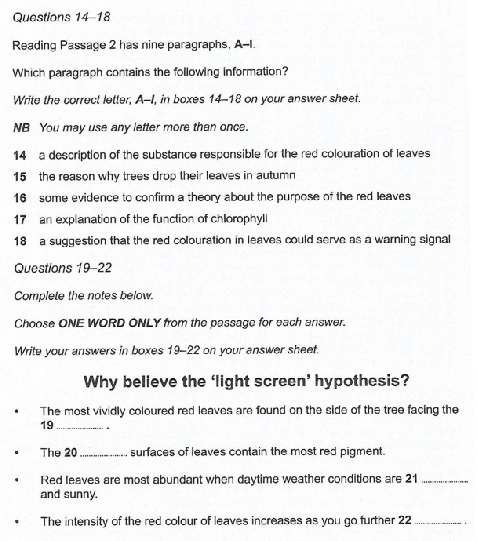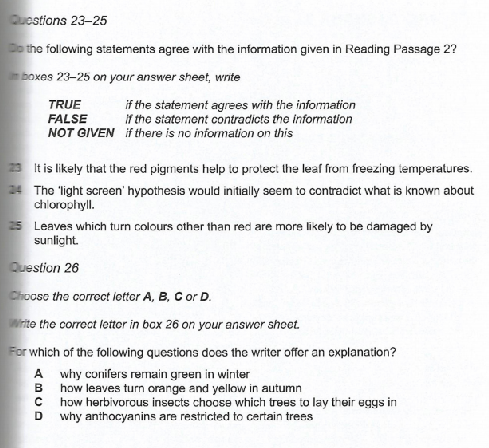剑桥雅思10阅读:Test3雅思阅读PASSAGE2真题+答案+解析
发布时间:2021-03-16 关键词:Passage2
Autumn Leaves
秋叶
Canadian Writer Jay Ingram Investigates the Mystery of Why Leaves Turn Red in the Fall
加拿大作家 Jay Ingram 调查树叶在秋关变红的秘密
A One of the most captivating natural events of the year in many areas throughout North America is the turning of the leaves in the fall. The colours are magnificent, but the question of exactly why some trees turn yellow or orange, and others red or purple, is something which has long puzzled scientists.
A.每年北美多个地区里最为迷人的自然事件之一,就是秋叶变色之时。叶子的颜色都很壮观美丽,但一个确切的问题还久久地困扰着科学家们,就是为什么一些树会变成黄色或橙色,而 其他树则变为红色或紫色。
B Summer leaves are green because they are full of chlorophyll, the molecule that captures sunlight and converts that energy into new building materials for the tree. As fall approaches in the northern hemisphere, the amount of solar energy available declines considerably.For many trees — evergreen conifers being an exception -the best strategy is to abandon photosynthesis* until the spring. So rather than maintaining the now redundantleaves throughout the winter, the tree saves its precious resources and discards them. But before letting its leaves go, the tree dismantles their chlorophyll molecules and ships their valuable nitrogen back into the twigs. As chlorophyll is depleted, other colours that have been dominated by it throughout the summer begin to be revealed. This unmasking explains the autumn colours of yellow and orange, but not the brilliant reds and purples of trees such as the maple or sumac.
B.夏天树叶是绿色的,因为它们有足够的叶绿素,而这些分子能捕捉到阳光,并将其转化成作为树木生长新原料的能量。当北半球秋天临近时,太阳能的可利用成分会大量地减少。对于树种来说——常绿松柏类植物是个例外——的应对措施是停止光合作用,直到春天到来。所以,树木与其在整个冬天里保留现有的多余叶子,倒不如保存珍贵的养料而丢弃它们。但在这些叶子凋落之前,树木会拆分它们的叶绿素分子,并将这些分子内有用的氮传送回细枝里。一旦叶绿素被耗尽,在夏天里因叶绿素的主导作用,而被抑制的其他颜色便开始显现。这个发现解释了秋叶的黄与橙,却并未解释出如同枫树和漆树一般的灿烂的红色和紫色。
C The source of the red is widely known: it is created by anthocyanins, water-soluble plant pigments reflecting the red to blue range of the visible spectrum. They belong to a class of sugar-based chemical compounds also known as flavonoids. What’s puzzling is that anthocyanins are actually newly minted, made in the leaves at the same time as the tree is preparing to drop them. But it is hard to make sense of the manufacture of anthocyanins—why should a tree bother making new chemicals in its leaves when it's already scrambling to withdraw and preserve the ones already there?
C. 红色的原料是众所周知的:它由不同的花青素提炼出来,一种在可见光谱中能显现红到蓝的水溶性植物色素。他们属于一个级别的糖本化合物,也称之为类黄酮。令人困惑的是花青素是新制成的,即树木准备让叶子凋零的时候才在叶子中生成。但树木生成花青素的行为难以被理解一为什么树木在它现有的叶子中吸收和保存花青素,还要忙着在叶子里制作新的这种化学物质?
D Some theories about anthocyanins have argued that they might act as a chemical defence against attacks by insects or fungi, or that they might attract fruit-eating birds or increase a leaf’s tolerance to freezing. However there are problems with each of these theories, including the fact that leaves are red for such a relatively short period that the expense of energy needed to manufacture the anthocyanins would outweigh any anti-fungal or anti-herbivore activity achieved.
D. 一些关于花青素的理论认为它们是用作防止昆虫和真菌伤害的化学防御,或是用于吸引以食果类为生的鸟类,或是增大叶子的耐寒能力。然而这些理论个个都存在问题,包括下面的事实:叶子保持红色的时期如此之短,以至于在该时期内制造花青素所需消耗的能量大于任何抗菌或抵抗食草动物活动所需的能量。
E It has also been proposed that trees may produce vivid red colours to convince herbivorous insects that they are healthy and robust and would be easily able to mountchemical defences against infestation. If insects paid attention lo such advertisements, they might be prompted to lay their eggs on a duller, and presumably less resistant host. The flaw in this theory lies in the lack of proof to support it. No one has as yet ascertained whether more robust trees sport the brightest leaves, or whether insects make choices according to colour intensity.
E. 它(理论)也建议,树木可以生成鲜艳的红色,让食草昆虫相信他们自身是健康强壮的,并能轻易地增加化学防御来抵抗感染。如果昆虫们注意到这些树木类似的“宣传”信心,它们可能地在一些暗沉的,抵挡性较弱的寄主上产卵。这个理论上的错误就在于缺乏事实依据的支撑。到现在为止,没有人能确定是否越强壮的树越能展示出明亮的树叶,或昆虫是否会根据颜色亮度来选择树木。
F Perhaps the most plausible suggestion as to why leaves would go to the trouble of making anthocyanins when they’re busy packing up for the winter is the theory known as the ‘light screen’ hypothesis. It sounds paradoxical, because the idea behind this hypothesis is that the red pigment is made in autumn leaves to protect chlorophyll, the light-absorbing chemical, from too much light. Why does chlorophyll need protection when it is the natural world’s supreme light absorber? Why protect chlorophyll at a time when the tree is breaking it down tosalvage as much of it as possible?
F. 或许看似最有理的推断是一个被称为“光屏”的假设。该假设解释了为什么叶子在忙着准备过冬时,不顾麻烦也去制造花青素。这听起来是矛盾的,因为这假设背后的想法是红色素是在秋叶中生成的,以此来保护叶绿素,这个吸光化学物,免受过强光源的伤害。为什么叶绿素需要保护,当它是自然界中质的光源吸收体?为什么正是树木折断需被抢救时要 尽可能保护叶绿素?
G Chlorophyll, although exquisitely evolved to capture the energy of sunlight, can sometimes be overwhelmed by it, especially in situations of drought, low temperatures, ornutrient deficiency. Moreover, the problem of oversensitivity to light is even more acute in the fall, when the leaf is busy preparing for winter by dismantling its internal machinery. The energy absorbed by the chlorophyll molecules of the unstable autumn leaf is not immediately channeled into useful products and processes, as it would be in an intact summer leaf. The weakened fall leaf then becomes vulnerable to the highly destructive effects of the oxygen created by the excited chlorophyll molecules.
G.尽管精妙地参与到捕捉太阳光能量的过程中,叶绿素有时也会被破坏,特别是当环境是干燥、低温或营养缺失时。这时的叶子正忙碌地为过冬分解内在机制。由摇摇欲坠的秋叶中的叶绿素分子吸收而来的能量,并不能立即被传送到有用的产物和过程中,因为它将构成一片完整的夏叶。老弱的秋叶是由活跃的叶绿素分子造成的,因受具有摧毁性作用的氧化影响而变得容易残破。
H Even if you had never suspected that this is what was going on when leaves turn red, there are clues out there.One is straightforward: on many trees, the leaves that are the reddest are those on the side of the tree which gets most sun. Not only that, but the red is brighter on the upper side of the leaf. It has also been recognised for decades that the best conditions for intense red colours are dry, sunny days and cool nights, conditions that nicely match those that make leaves susceptible to excesslight. And finally, trees such as maples usually get much redder the more north you travel in the northernhemisphere. It’s colder there, they're more stressed, their chlorophyll is more sensitive and it needs more sunblock.
H. 即便你不曾怀疑叶子变红时发生了什么,但迹象已经摆在眼前。首先能明确的是:对于许多树而言,最红的叶子都是在树木近阳的一面。不仅这样,最发亮的红也出现在叶子的最顶端。为世代所认识的是,对于形成深红颜色的条件是干燥、晴天和凉爽的夜晚,这是让叶子程度吸光的条件。最后,如例如枫树一般的树木在北半球越北的地方,叶子就会越红。那里更冷, 树木会感到更有压迫,而它们的叶绿素也会更敏感,需要的阳光。
I What is still not fully understood, however, is why some trees resort to producing red pigments while others don't bother, and simply reveal their orange or yellow hues. Do these trees have other means at their disposal to prevent overexposure to light in autumn? Their story, though not asspectacular to the eye, will surely turn out to be as subtle and as complex.
I.然而,仍未探明的是为什么一些树木借助生成红色素,而其他则不用,就能轻易地显示出他们的黄橙色调。是那些树有别的解决方法去阻挡在秋天的过分暴晒吗?他们的故事,或许在我们眼里并不惊人,但必定精妙而复杂。
……


Question 14
参考译文: 关于某种负责叶子变成红色的物质的相关描述难度及答案: 难度中等,答案为 C
关键词: substance、red colouration
定位原文: C 段首句“The source of ... Visible spectrum.” 红色的来源是众所周知的:它由不同的花青素提炼出来,一种在可见光谱中能显现红到蓝的水溶性植物色素。
解题思路: 关键词“substance”相当于原文中的“ anthocyanins” 原文讲述了叶子红色素的来源为花青素,接着又描述了花青素的相关特性。
Question 15
参考译文: 秋天树木落叶的原因难度及答案: 难度中等;答案为 B
关键词: reason、drop、autumn
定位原文: B 段前 4 句“summer leaves... discards them.”夏天树叶是绿色的,因为它们有足够的叶绿素,而这些分子能捕捉到阳光,并将其转化成作为树木生长新原料的能量,当北半球临逬秋天时,太阳能的可利用成分会大量地减少。对于树种来说——常绿松柏类植物是个例外——的应对措施是停止光合作用, 直到春天到来。所以,树木与其在整个冬天里保留现有的多余叶子,倒不如保存珍贵的养料而丢弃它们。
解题思路: B 段阐释了树木落叶是因为秋天时,太阳能可利用率减少,所以它们丢弃多余的叶子,停止光合作用且保存养料。
Question 16
参考译文: 关于确认红叶目的理论的一些证据难度及答案: 难度中等;答案为 H
关键词: evidence 、confirm 、 theory 、 purpose 、 red leaves
定位原文:H 段前 3 句“Even if you had never... of the leaf.”即便你不曾怀疑叶乎变红时发生了什么,但迹象已经摆在眼前。首先能明确的是:对于许多树而言,最红的叶子都是在树木近阳的一面。不仅这样,最发亮的红叶出现在叶子的最顶端。
解题思路: H 段指出红叶目的理论的一些证据,即最红的叶子都是在树木近阳的一面,不仅这样,最发亮的红叶出现在叶子的最顶端。
Question 17
参考译文: 关于叶绿素功能的一种解释难度及答案: 难度低;答案为 B
关键词: explanation 、 function、 chlorophyll
定位原文:B 段首句“Summer leaves…for the tree.”夏天树叶是绿色的,因为它们有足够的叶绿素,而这些分子能捕捉到阳光,并将其转化成作为树木生长新原料的能量。
解题思路:B 段第 1 句解释了叶绿素的功能,即能捕捉到阳光,并将其转化成作为树木生长新原料的能量。
Question 18
参考译文: 一种推测:即叶子的红色变化过程可以作为一种提醒信号。难度及答案: 难度中等;答案为 E
关键词:red colouration、warning signal
定位原文: E 段前 2 句“It has also…less resistant host.”它(理论)也建议,树木可以生成鲜艳的红色, 让食草昆虫相信他们自身是健康强壮的,并能轻易地增加化学防御来抵抗感染。如果昆虫们注意到这些树木类似的“宣传”信心,它们可能地在一些暗沉的,抵挡性较弱的寄主上产卵。
解题思路: E 段前 2 句介绍到叶子的红色可以发出提醒信号,让昆虫相信它们是健康的而从防止感染 。 关键词 “ warning signal, ” 相当于原文中的 “advertisement”。
Question 19
参考译文: 可以在树木面向_____的一边发现最红的叶子。难度及答案: 难度低;答案为 sun(light)
关键词: the most vividly、red、facing
定位原文: H 段第 2 句 “One is straightforward... which gets most sun.首先能明确的是:对于许多树而言,最红的叶子都是在树木最近阳的一面。
解题思路: 关键词“the most vividly”相当于原文中的“the reddest,由 H 段第—句可得知答案为 sun(light)。
Question 20
参考译文: 叶子__的面含有最多的红色素。难度及答案: 难度低;答案为 upper
关键词: surface 、the most red pigment
定位原文: H 段第三句“Not only that,…upper side of the leaf”不仅这样,最发亮的红也出现在叶子的最顶端。
解题思路: 关键词“surface”相当于原文中的“side”,由 H 段第三句可得知答案为 upper。
Question 21
参考译文: 当白天天气条件为____和阳光明媚时,红叶的数量最多。难度及答案: 难度低;答案为 dry
关键词: most abundant、weather conditions、sunny
定位原文:H 段第 4 句“It has also been…to excess light.”为世代所认识的是,对于形成深红颜色的条件是干燥、晴天和凉爽的夜晚,这是让叶子程度吸光的条件。
解题思路: 关键词“most abundant”相当于原文中的“intense”,由原文可以直接得出答案为 dry。
Question 22
参考译文: 当你走到越_____部时,你会发现叶子红色的程度会增加。难度及答案: 难度低;答案为 north
关键词: intensity、increases、go further
定位原文: H 段倒数第 2 句“And finally,…northern hemisphere.”最后,例如枫树一般的树木在北半球越北的地方,叶子就会越红。
解题思路: 由 H 段倒数第 2 句可知答案为 north。
Question 23
参考译文:很可能叶子的红色有助于保护叶子免受低温干扰。难度及答案: 难度中等;答案为 FALSE
关键词: red pigments、freezing temperatures
定位原文: D 段第 1 句 “Some theories about anthocyanins... to freezing.” 一些关于花青 素的理论认为它们是用作防止昆虫和真菌伤害的化学防御,或是用于吸引以食果类为生的鸟类,或是增大叶子的耐寒能力。但是第二句又说了,这些理论是存在问题的。
解题思路: 文中 D 段中指出花青素的化学防御等作用,但又指出理论存在问题。故答案为 FALSE。
Question 24
参考译文: 光屏假设开始似乎与叶绿素的已知知识相矛盾。难度及答案: 难度中等;答案为 TRUE
关键词: initially、 contradict
定位原文: F 段第 2 句 “It sounds paradoxical…from too much light.” 这听起来是矛盾的, 因为这想法背后的假设是秋叶中生成的红色素是为了保护叶绿素,这个吸光化学物,免受过强光源的伤害。
解题思路: 关键词“contradict”相当于原文中的“paradoxical”,F 段第二句解释了为什么光屏假设会听起来矛盾。
Question 25
参考译文: 转变为除红色外其他颜色的叶子更有可能受到阳光的伤害。难度及答案:难度高; NOT GIVEN
关键词: other than、 damaged by sunlight
定位原文: I 段首句“What is still...yellow hues.”然而,仍未探明的是为什么一些树木借助生成红色素,而其他则不用,就能轻易地显示出他们的黄橙色调。
解题思路: 文中提到秋天时,有的树木显现出黄橙色调,但并没有提到转变为除了红色外其他颜色的叶于更有可能受到阳考的伤害。故答案为 NOT GIVEN。
Question 26
参考译文: 下面哪一个问题,作者提供了相应的一个解释。难度及答案: 难度中等;答案为 B
关键词: explanation
定位原文: B 段倒数第 3 句至最后一句“But before letting…or sumac.”但在这些叶子凋落之前,树木会拆分它们的叶绿素分子,并将这些分子内有用的氮传送回细枝里。一旦叶绿素被耗尽,在夏天里因叶绿素的主导作用,而被抑制的其他颜色便开始显现。这个发现解释了秋叶的黄与橙,却并未解释出如枫树和漆树一般灿烂的红色和紫色。
解题思路: 答案 B 中问题意思是“秋天叶子是如何转变为橙色和黄色的”, B 段倒数第 3 句给出了详细的解释。




